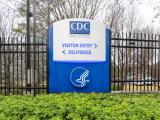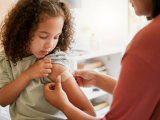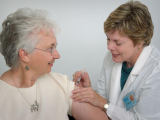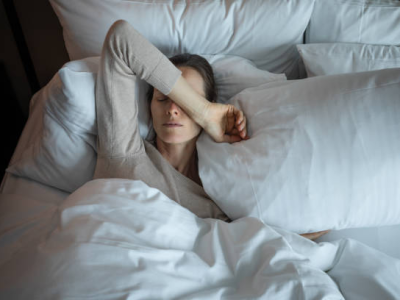Dec 9, 2009 (CIDRAP News) – About the same percentage of Americans were vaccinated against seasonal influenza this year as received vaccine last year, according to a survey released today that undercuts perceptions of extraordinary demand driven by pandemic-fueled awareness.
The survey by scientists at the nonpartisan research organization the RAND Corporation found that by mid-November 2009, 32% of U.S. adults had been vaccinated against seasonal flu, compared with 30% of adults at the same point in 2008. Among adults who are specifically recommended to take the vaccine, 37% had done so.
The survey, based on a nationally representative sample of 5,679 white, black, and Hispanic adults, was published on the Web today and released in a press briefing hosted by the National Foundation for Infectious Diseases (NFID), an educational organization.
Katherine Harris, PhD, a RAND economist and lead author of the survey, said: "It does not appear that the increased public discussion of the role of influenza vaccines has had a significant impact on the public's behavior. Most of the results from our latest survey look much like those from last year." (In separate work published in May, the same RAND research team found that 38% of U.S. adults were vaccinated over the entire 2008-09 flu season.)
However, the survey showed that people began to seek vaccination much earlier this year, with three times as many people vaccinated in September as in 2008, a more typical year when relatively little seasonal vaccine was available that early. Nine percent of adults were vaccinated by the end of September, but the trend slowed in October, with a cumulative 30% vaccinated, and slowed much more in November, when the cumulative total reached 32%.
A slowdown in flu vaccination commonly occurs near Thanksgiving, Litjen Tan, PhD, director of medicine and public health for the American Medical Association, said during the briefing. “It is . . . extremely critical to prevent that complacency” this year, because seasonal flu has yet to hit, he said.
Spot shortages of seasonal vaccine that were reported around the country may have played a role in the slowdown, Harris said. Among the 17% of adults who have not yet been vaccinated but said they intend to be, 38% reported that they sought the shot but found no vaccine available.
But she also pointed to incorrect beliefs about flu vaccine that were widely shared by people who had not been vaccinated and did not intend to be. Among 2,417 respondents who did not take the fu shot and did not intend to (51% of the total surveyed), 22% thought they were not at risk from flu, 21% said they did not believe in flu vaccine, and 17% expressed a fear of side effects.
Experts at the briefing said they are particularly troubled by low rates of vaccination among people in high-risk groups. By mid-November, only 49% of healthcare workers, 50% of those with heart disease and chronic lung diseases, 43% of those older than 50, and 37% of those with asthma had been vaccinated. People “are putting themselves at risk for severe complications but don’t seem to understand they are at risk,” Tan said.
The experts urged people to continue to seek seasonal flu vaccine, noting that the traditional flu season has just begun and does not normally peak until February. Almost 10 million doses of seasonal flu vaccine remain to be delivered out of a promised 114 million, said Dr. William Schaffner, the NFID’s president-elect and chairman of preventive medicine at Vanderbilt University: “There is vaccine in the distribution channel and more will be coming along,” he said.
See also:
RAND report: "Seasonal Influenza Vaccine Use by Adults in the U.S. During the 2009-2010 Vaccination Season: A Snapshot as of Mid-November 2009"
http://www.rand.org/pubs/occasional_papers/2009/RAND_OP289.pdf



















